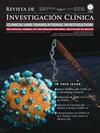ASSOCIATION BETWEEN APOE-ε4 CARRIER STATUS AND QUALITATIVE NEUROIMAGING CHARACTERISTICS IN OLDER ADULTS WITH MILD COGNITIVE IMPAIRMENT.
IF 1.4
4区 医学
Q2 Medicine
Revista De Investigacion Clinica-Clinical and Translational Investigation
Pub Date : 2022-03-24
DOI:10.24875/ric.21000550
引用次数: 0
Abstract
BACKGROUND The pathogenesis of mild cognitive impairment (MCI) is multifactorial and includes the presence of genetic variants such as the ε4 allele of the apolipoprotein E gene (APOE-ε4). Association between the APOE-ε4 carrier status and deleterious structural and functional changes on magnetic resonance imaging (MRI) has been previously described in individuals with Alzheimer's disease. However, the central nervous system changes may possibly develop in earlier stages of cognitive impairment, as reflected in MCI. OBJECTIVE The objective of the study was to determine the association between APOE-ε4 carrier status and qualitative changes on MRI (medial temporal and parietal atrophy), as well as the detection of white matter hyperintensities (WMH) in older adults with MCI, in the memory clinic of a tertiary care hospital in Mexico City. METHODS A cross-sectional study of 72 adults aged 60 years or above who underwent an exhaustive clinical, neuroimaging, and neuropsychological evaluation. Multivariate logistic regression models were constructed to determine the association between APOE-ε4 carrier status and qualitative/quantitative changes on MRI. RESULTS Mean age was 75.2 years (± 7.2) and 64% were female. Twenty-one participants were cognitively normal and 51 had MCI. Almost 56% were APOE-ε4 carriers and were associated with medial-temporal atrophy according to the Scheltens scale (odds ratio [OR]: 20.0, 95% confidence intervals [CI]: 3.03-131.7), parietal atrophy according to the Koedam's score (OR: 6.3; 95% CI 1.03-39.53), and WMH according to the Fazekas scale (OR: 11.7, 95% CI: 1.26-108.2), even after adjusting for age, educational level, and cardiovascular risk factors. CONCLUSION The APOE-ε4 carrier status was associated with medial temporal and parietal atrophy, as well as WMH. Our findings support the hypothesis suggesting the contribution of this genotype to neurodegeneration and cerebral vascular pathology.老年轻度认知障碍患者apoe -ε4携带状态与定性神经影像学特征的关系
背景:轻度认知障碍(MCI)的发病机制是多因素的,包括载脂蛋白E基因(APOE-ε4)的ε4等位基因等遗传变异的存在。APOE-ε4载体状态与磁共振成像(MRI)上有害的结构和功能变化之间的关联先前已在阿尔茨海默病患者中得到描述。然而,中枢神经系统的改变可能发生在认知障碍的早期阶段,正如MCI所反映的那样。目的研究APOE-ε4携带状态与MRI质变(内侧颞叶和顶叶萎缩)以及MCI老年人白质高信号(WMH)检测之间的关系,研究对象为墨西哥城某三级医院记忆门诊患者。方法对72名60岁或以上的成年人进行了详尽的临床、神经影像学和神经心理学评估的横断面研究。建立多因素logistic回归模型,确定APOE-ε4携带者状态与MRI定性/定量变化的关系。结果患者平均年龄75.2岁(±7.2岁),女性占64%。21名参与者认知正常,51名患有轻度认知障碍。根据Scheltens量表(比值比[OR]: 20.0, 95%可信区间[CI]: 3.03-131.7), APOE-ε4携带者约56%与中颞叶萎缩相关,根据Koedam评分(OR: 6.3;95% CI 1.03-39.53),根据Fazekas量表(OR: 11.7, 95% CI: 1.26-108.2),即使在调整了年龄、教育水平和心血管危险因素后也是如此。结论APOE-ε4携带状态与内侧颞叶和顶叶萎缩及WMH相关。我们的研究结果支持了该基因型对神经变性和脑血管病理的贡献的假设。
本文章由计算机程序翻译,如有差异,请以英文原文为准。
求助全文
约1分钟内获得全文
求助全文
来源期刊
CiteScore
3.00
自引率
0.00%
发文量
60
审稿时长
>12 weeks
期刊介绍:
The Revista de Investigación Clínica – Clinical and Translational Investigation (RIC-C&TI), publishes original clinical and biomedical research of interest to physicians in internal medicine, surgery, and any of their specialties. The Revista de Investigación Clínica – Clinical and Translational Investigation is the official journal of the National Institutes of Health of Mexico, which comprises a group of Institutes and High Specialty Hospitals belonging to the Ministery of Health. The journal is published both on-line and in printed version, appears bimonthly and publishes peer-reviewed original research articles as well as brief and in-depth reviews. All articles published are open access and can be immediately and permanently free for everyone to read and download. The journal accepts clinical and molecular research articles, short reports and reviews.
Types of manuscripts:
– Brief Communications
– Research Letters
– Original Articles
– Brief Reviews
– In-depth Reviews
– Perspectives
– Letters to the Editor

 求助内容:
求助内容: 应助结果提醒方式:
应助结果提醒方式:


